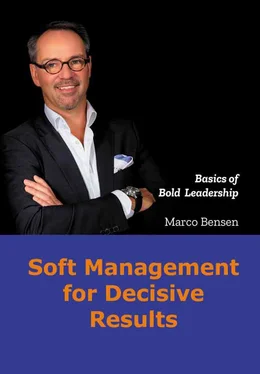I have had my personal definition of leadership for a very long time and it is based precisely on this premise: Leadership is the ability to motivate people independently in the direction of a common goal by means of integrity, inspiration, and support, with the help of a vision.
For everyday life, however, I use a simple definition that also fits more with bold leadership and simple leadership
Leadership is easy: Just take care of your people! Marco Bensen
I will never claim that I know more than others. However, I can definitely say that I have examined, studied, and collected significant information from theory and practice on all leadership topics, including 25 years of leadership experience. In addition to studies, seminars, books and articles, this also includes a large number of personal conversations with real leaders from various industries. Combining all this theoretical and practical information, I have synthesized highly solid information on leadership. You will find it all in this book, so all you need to do is process the information and filter out what you need.
You will find that I am an absolute believer in soft management – soft leadership. Put simply, that means having a positive focus on employees. Only inspired and satisfied employees will achieve optimal performance in the mid- and long term. Soft management is by no means about softness, about an ideal world or being sweet and nice. It’s about tough facts like performance, goals, and results. For me, employee-oriented leadership is the true spirit of leadership.
The hotel and catering industry, where I was privileged to gain my experience, is part of the service industry and as such, an industry par excellence where people management plays an absolutely crucial role. However, leadership principles are universal and apply to all industries and organizations that work with people. Bad people management will lead to even the most well-regarded company performing far below its potential. Proper people management and leadership, on the other hand, will do wonders and will also jumpstart even a mediocre company into top performance.
Soft Management and Hard Management
Leadership is easy: Take care of your people and both you and your organization will be successful.
As simple as this sounds, obviously it is more difficult in day-to-day life. There are so many great managers out there, but finding the right leaders is another issue. How do you recognize leaders? Well, leaders move us and they inspire us to perform at our best. True leadership is not tangible, but you know when it is there; it works through emotion, inspiration ... and through success.
Leadership is all about people; it’s about inspiring people to believe in themselves. To believe that anything is possible and to believe in something much greater than your own self-preservation. When we have that kind of influence as leaders, great things happen. Thomas Gifford
In the several decades that I have been working in the hotel industry, I have met countless executives at different levels. Some were my direct superiors while others worked at a different or higher level in the organization, but many were also colleagues on an equal level or managers who reported to me.
And of course, I also ran into many executives from other organizations and industries. There were so many inspiring executives who really had something to show for themselves, who could think outside the box, and from whom one could really learn a lot. They understood how to set an example, how to communicate properly with others, how to get people going, and how to focus on the right things.
On the other hand, I have also met executives who (mostly unconsciously) slowed others down, who covered up their insecurity with arrogance, and who had their focus on anything but the team. You can learn a lot from both types of manager; however, the important thing is understanding what to apply and what to avoid from what you have learned.
In any case, the leadership styles of these two manager-types can clearly be differentiated from each other. Executives who don’t have their employees behind them, lead with a clear focus on the hard side of management. Executives who understand leadership and who are able to inspire others, generally have a soft leadership style.
Soft vs. Hard Management
Focus of Management
In management there is a continuum between hard and soft.
The hard part is management that creates plans, sets up structures and monitors the performance. Focus is on the task and on the results. Management is more aggressive and it’s all about the bottom line.
With soft management on the other hand, focus is on employees. It is a humane management style that is largely based on emotions and in which the focus is on dealing with each other and on communication.
Let me add right here that soft management is by no means about soft personalities. On the contrary, it takes a strong leadership personality to apply soft management. Executives cannot afford to be insecure and have a too much self-doubt. They need the focus for the personalities in the team and the related needs and emotions. Herewith it is also said that hard management doesn’t need a tough cookie to implement it. Hard management can be carried out by both strong and weak managers. For soft management and bold leadership, it definitely requires a strong leader.
“The challenge of leadership is to be strong but not rude; to be kind but not weak; to be brave but not intimidating; to be thoughtful but not lazy; to be humble but not shy; to be proud but not arrogant; To have a sense of humor, but without being a fool. “ Jim Rohn
Soft management – motivating employees and giving meaning to work – has nothing to do with pampering the staff; it is all about respect for individuals. And it’s about the realization, that encouragement, freedom, support and good communication enable employees to develop themselves and to make a valuable contribution to the team and the company.
It is important not to confuse soft and hard management with soft and hard skills, even though there are overlaps. Hard skills relate to characteristics such as competencies and knowledge. Soft skills are about personality traits and skills like leadership style, communication skills, etc. Managers need both distinctive hard skills and soft skills to be successful. However, expertise does not come overnight, it has to be built up. Soft skills form the basis on which the hard skills can develop.
It permeates mercilessly through all organizations: Soft leadership, i.e., positive focus on people, moves an organization forward. Hard leadership, i.e., focusing exclusively on results, leads to decay in the medium and long term.
Too much focus on the hard side of management can lead to linear performance improvement at best. However, a focus on the soft, non-linear side will lead to exponential performance improvement.
Soft management is indisputably the more effective management style; it is the true spirit of leadership and achieves better results than hard management.
Theory X and Y and their self-fulfilling prophecy
Theories X and Y are leadership philosophies, recognized in theory and science, developed by American management professor Douglas McGregor. The leadership styles used here are based on assumptions about human nature in relation to behaviour at work.
Theory X represents leadership by authority, since it assumes that humans are inherently lazy and perceive work as negative. In this theory employees do not develop their own motivation but must receive their impetus from outside. Work functions solely through guidance and complete external control is therefore required. Managers who see their employees in this way and who advocate this management philosophy must necessarily apply an authoritarian management style. Otherwise, at least in their eyes, the organization cannot function correctly. Basically, with Theory X, there is distrust on both sides.
Читать дальше












